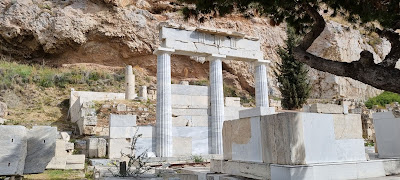27 March 2025 – The Acropolis, Athens
Miles
driven today = 0
Total Miles
to date = 2,350
Lisa has been to Athens before. She has fond memories of marching around the Parthenon aged 8 with her father and has also been back since, so she had no real desire to go back again and decided on a van day while I got myself on the 304 bus and then the Metro to tick off somewhere which I guess must be on most people’s bucket lists.
On entering through the South Eastern gates this is the first view that you have of the slopes below the Acropolis itself. It’s thought that the area was inhabited as early as 5,000 BC and in 1500 BC it was fortified with Cyclopean walls like the ones we saw in Mycenae the other day. It had a palace and was significantly inhabited until the Oracle at Delphi decreed in 510 BC that it should become the domain purely of the Gods.
The first significant architecture we come across is the Theatre of Dionysos, which has only been partially restored. It was first erected in the 5th Century BC but greatly extended over the following couple of centuries.
The Theatre’s stage building was one of the later additions allowing for more complex productions as well as improving the acoustics.
The Stoa of Eumenes lined the original road around the Acropolis, was 2 storeys high and stretched for a distance of 167 metres. It’s named after its donator Eumenes II, King of Pergamon who ruled from 197 BC to 159 BC.
The Sanctuary of Asklepios was dedicated to the God of the same name and his daughter Hygieia, “the personification of health”.
The Roman Herodes Atticus Theatre from the 2nd Century AD has been extensively restored and is used for classical concerts.
It has a diameter of 76 metres, a capacity of 6,000 spectators and incredibly had an unbraced cedarwood roof.
Unsurprisingly it got fairly crowded at times and there are a few pinch points where you have to wait for a large party to move on before you can progress. This is the Propylaia which forms the main gateway to the summit of the Acropolis.
Construction started in 437 BC but it was interrupted by the Peloponnesian War and so the original plan was never completed. The building was converted for several different purposes over the course of the intervening years.
This is the first view you currently have of the Parthenon. It’s a constantly ongoing restoration project. The first large scale restoration was done in the 19th century but they used iron and concrete which actually damaged the marble columns even further.
The Temple was dedicated to the Goddess Athena. Building was completed in 438 BC and all of the sculptures which adorned it took a further 6 years.
The columns aren’t straight. They actually bulge slightly like baobab trees. A completely deliberate design to make their appearance more natural and fluid.
The sculptures around the tops of the temple must have looked phenomenal when they were all freshly carved and in situ. I later saw an interesting film in the Acropolis Museum explaining their meanings.
The Erechtheion was believed to have been built on the site of where Athens’ previous patron God Poseidon did battle with Athena in a competition judged by the other Gods. Athena won and the City bears her name as a result.
Its most impressive feature are the 6 “Caryatids” which form some of its columns. These are copies. 5 of the originals are in the museum. The 6th was pilfered by Lord Elgin.
There are several viewpoints giving impressive vistas of the Athenian skyline.
Having had a good wander around and viewed all the monuments from every conceivable angle. I headed for the exit. In a display of largely broken marble pieces I found this interesting relief on a 2nd Century BC cylindrical altar to Dionysus.
The Acropolis Museum is an impressive building completed in 2009. It was built over the foundations of ancient Athens which were uncovered during construction. Many of the more interesting ruins can be viewed through glass sections of the museum’s flooring.
Once again I was flabbergasted by how well preserved some of the exhibits inside were considering their age. These pottery pieces were recovered from a grave from the 8th Century BC. Note the swastika pattern on the flattish bowl at the back right.
Roman terracotta statues of the Goddess Nike from the 1st to 3rd Centuries AD.
6th Century BC jugs. The one on the right depicts a wedding procession.
Various figures from the 4th Century BC.
“Lekythoi” with black figure depictions dating from between 510 BC and 450 BC.
A frieze from the mid 2nd Century BC depicting Apollo and Hermes with Nymphs while Pan plays a flute to the left.
A 3 bodied Daemon relief from one of the temples. There were many exquisite sculptures but unfortunately after this point photography is forbidden.
Of course there is one glaring omission and that is the Pantheon Marbles which were looted by Lord Elgin and ended up in the British Museum. This is of course a model of the central section showing Athena and Poseidon mid-competition. I don’t know what the latest state of play is regarding getting the marbles repatriated but it really can’t happen soon enough.
I know that there is an awful lot more to Athens than just the Acropolis but I was pretty much bushed after all that. So I found myself a table at one of the less heavily populated tavernas and tucked into a healthy bowl of Mediterranean Salad before jumping on the metro and heading back to the Coast.





























Comments
Post a Comment